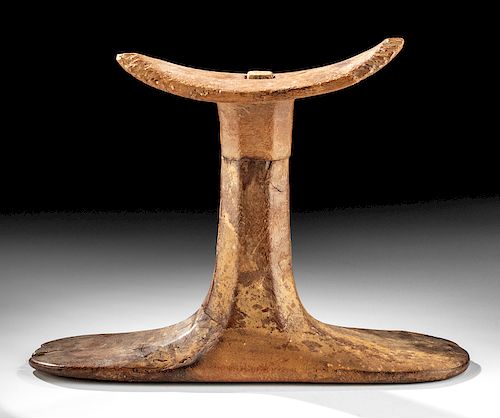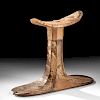Egyptian Late Dynastic Wooden Mummy Headrest
Lot 1
About Seller
Artemis Fine Arts
686 S Taylor Ave, Ste 106
Louisville, CO 80027
United States
Selling antiquities, ancient and ethnographic art online since 1993, Artemis Gallery specializes in Classical Antiquities (Egyptian, Greek, Roman, Near Eastern), Asian, Pre-Columbian, African / Tribal / Oceanographic art. Our extensive inventory includes pottery, stone, metal, wood, glass and textil...Read more
Estimate:
$2,000 - $3,000
Absentee vs Live bid
Two ways to bid:
- Leave a max absentee bid and the platform will bid on your behalf up to your maximum bid during the live auction.
- Bid live during the auction and your bids will be submitted real-time to the auctioneer.
Bid Increments
| Price | Bid Increment |
|---|---|
| $0 | $25 |
| $300 | $50 |
| $1,000 | $100 |
| $2,000 | $250 |
| $5,000 | $500 |
| $10,000 | $1,000 |
| $20,000 | $2,500 |
| $50,000 | $5,000 |
| $100,000 | $10,000 |
| $200,000 | $20,000 |
About Auction
By Artemis Fine Arts
Sep 5, 2019
Set Reminder
2019-09-05 10:00:00
2019-09-05 10:00:00
America/New_York
Bidsquare
Bidsquare : Ancient / Ethnographic From Around The World
https://www.bidsquare.com/auctions/artemis-gallery/ancient-ethnographic-from-around-the-world-4405
Variety galore! Featuring ancient art from Egypt, Greece, Italy and the Near East, as well as Asian, Fossils, Pre-Columbian, Native American, African / Tribal / Oceanic, Spanish Colonial, Russian Icons, Fine art, much more! All categories, all price ranges... Artemis Fine Arts info@artemisgallery.com
Variety galore! Featuring ancient art from Egypt, Greece, Italy and the Near East, as well as Asian, Fossils, Pre-Columbian, Native American, African / Tribal / Oceanic, Spanish Colonial, Russian Icons, Fine art, much more! All categories, all price ranges... Artemis Fine Arts info@artemisgallery.com
- Lot Description
Egypt, Late Dynastic Period, 26th to 31st Dynasty, ca. 664 to 332 BCE. A finely-preserved wooden headrest carved in two sections used to support the head of a mummy. Headrests were of this type (constructed from two or more separate sections) are believed to have had several functions. The Egyptians normally slept on their sides and the curved upper section held the head above the bed. At their most prosaic, the headrests were frequently buried with the mummy providing a place to rest the deceased's head and were found inside the coffin. Also, the importance of elevating the head was integral with their religious practices as it was intended to aid in resurrection mimicking the sun god rising above the horizon and playing a part in the "Opening of the Mouth" ceremony described in the Egyptian Book of the Dead (or the "Book of Going Forth by Day"). Size: 9.7" W x 7.25" H (24.6 cm x 18.4 cm).
For a stylistically-similar example of the upper headrest portion with extended lateral fins, please see the Los Angeles County Museum of Art, accession number M.80.202.7: https://artsandculture.google.com/asset/headrest-with-dual-carved-images-of-bes-emerging-from-a-lotus-blossom/jwEhpf00KH1_Dg
Provenance: private Pennsylvania, USA collection; ex-William Ashby collection
All items legal to buy/sell under U.S. Statute covering cultural patrimony Code 2600, CHAPTER 14, and are guaranteed to be as described or your money back.
A Certificate of Authenticity will accompany all winning bids.
We ship worldwide and handle all shipping in-house for your convenience.
#149014Small losses to base and head rest. Upper head rest component is detachable from the lower body. Nicks and abrasions to both components, with a few stable fissures to lower body, and minor staining. Light earthen deposits and great patina throughout.Condition
- Shipping Info
-
All shipping is handled in-house for your convenience. Your invoice from Artemis Gallery will include shipping calculation instructions. If in doubt, please inquire BEFORE bidding for estimated shipping costs for individual items.
-
- Buyer's Premium



 EUR
EUR CAD
CAD AUD
AUD GBP
GBP MXN
MXN HKD
HKD CNY
CNY MYR
MYR SEK
SEK SGD
SGD CHF
CHF THB
THB















